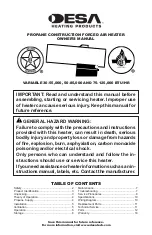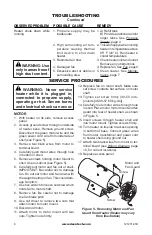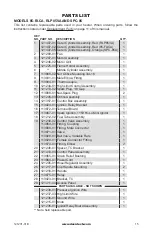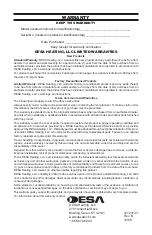
www.desatech.com
121231-01B
4
tHeory oF oPeration
Air For Combustion
And Heating
Fuel
Combustion Chamber
Figure 2 - Cross Section Operational View (Heater may vary from illustration)
Clean
Heated
Air Out
(Front)
Cool
Air In
(Back)
Fan
Motor
Power Cord
Hose/Regulator
Assembly
Nozzle
The Ignition System:
The spark transformer
and spark plug lights the main burner
The Safety Control System:
This system
causes the heater to shut down if the flame
goes out.
Note: Some parts are located differently on
some models.
ProPane suPPLy
The Fuel System:
The hose/regulator assem-
bly attaches to the propane gas supply. The
propane gas moves through the automatic
control valve and out the nozzle.
The Air System:
The motor turns the fan. The
fan pushes air into and around the combustion
chamber. This air is heated and provides a
stream of clean, hot air.
Propane gas and propane tank(s) are to be
furnished by the user.
Use this heater only with a propane vapor
withdrawal supply system. See Chapter 5
of the
Standard for Storage and Handling of
Liquefied Petroleum Gas, ANSI/NFPA 58
.
Your local library or fire department will have
this booklet.
The amount of propane gas ready for use
from propane tanks varies. Two factors decide
this amount:
1. The amount of propane gas in tank(s)
2. The temperature of tank(s)
The following chart shows the number of 100 lb
(45 kg) tanks needed to run this heater.
Number of tanks
Temperature
Models
at tank location
55 85
125
above 20° F (-7° C)
1 1
2
20° F (-7° C) to -0 (-18° C) 1 2
3
below -0° F (-18° C)
2 2 (Use larger
tank)
Smaller tanks can be used for limited run
times but it is recommended to use larger
tanks for optimum performance.
Less gas is vaporized at lower temperatures.
You may need two or more 100 pound (45
kg) tanks or one larger tank in colder weather.
Your local propane gas dealer will help you
select the proper supply system. The minimum
surrounding-air temperature rating for each
heater is -20° F (-29° C).





































